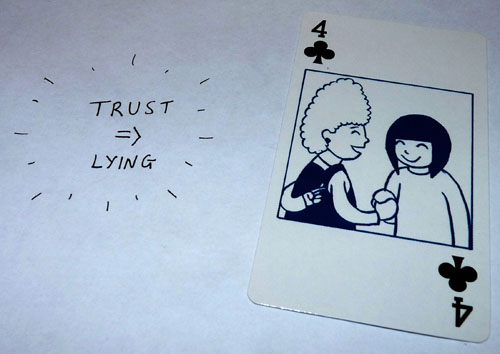Puzzle
This week, try testing your ability to kern.
If you liked that, try the splines.
Video
It’s easy to get overexcited about human progress, when in the grand scheme of things we’re still pretty small fry. I would periodically remind myself of this by considering that for all our ingenuity, we still couldn’t make a robot the size of a bird that could fly like a bird. Thanks to the determined efforts of Festo, I’m going to need to come up with something else.
Link
I’ve seen this link crop up in a few places now, but for good reason – I think this is some really important stuff that we are collectively getting wrong on a large scale right now: “The Social Graph is Neither” by maciej.
Cutting large swathes of great text for concision, here’s my favourite part of the argument:
[…] declaring relationships explicitly is a social act […] Social graph proponents seem uninterested in th[is] signaling problem. […] [and] how does cutting ties actually work socially? […] In real life, all relationships fade naturally if you don’t maintain them, but right now social networks preserve ties in amber until we explicitly break them […] Can I unfollow my ex now, or is that going to make her think I’m still hung up on her?
[…] You might almost think that the whole scheme had been cooked up by a bunch of hyperintelligent but hopelessly socially naive people, and you would not be wrong.
However, after a lot of good stuff, it ends with something of a shrug:
It’s just a matter of waiting things out, and leaving ourselves enough freedom to find some interesting, organic, and human ways to bring our social lives online.
I’m not sure that’s quite the right way to put it. I don’t think it’s about bringing our social lives online. Its more about augmenting our social lives with online functionality that goes with the grain of human nature.
That said, leaving ourselves enough freedom is critical. Quite how we do that is a topic for another day.
Quote
In the early 1970’s, Richard Nixon asked Zhou Enlai what he thought of the French Revolution. Zhou notoriously responded:
It is too soon to say.
Which everyone thought was quite wonderfully representative of Chinese sagacity.
This year it emerged that the whole thing was a misunderstanding too delicious to invite correction, as Zhou thought Nixon was referring to the much more recent student riots in Paris.
But this doesn’t matter, because the misread quote still stands as a useful reminder that we should err towards taking a longer-term view when evaluating the benefits of things. On a similar note, Ben Hecht says:
Trying to determine what is going on in the world by reading newspapers is like trying to tell the time by watching the second hand of a clock.
Last Week’s Question
Last week I asked: when someone says “next Thursday” on a Monday, which Thursday do they mean?
Richard’s response was the same as mine – always clarify. However, where I was aware of two interpretations, he identified three [This part added thanks to Richard’s clarification – T.M. 25/11/11]:
I have come across three possible scenarios:
(a) this = first occurrence, next = second occurrence
(b) this = occurrence in the week you’re in, next = occurrence in the following week
(c) this = occurrence in the week you’re in, next = first occurrenceI don’t think anyone actually uses (a).
Personally I use (b).
I have met people who use (c).To give some examples, on a Tuesday, referring to “This Monday”
and “Next Monday”.(a) This Monday = 6 days times, Next Monday = 13 days time
(b) This Monday = -1 days time, Next Monday = 6 days time
(c) This Monday = -1 days time, Next Monday = 6 days timeI can’t think of anyone who would use (a). (b) and (c) agree.
Another example, on a Tuesday, referring to “This Friday” and
“Next Friday”.(a) This Friday = 3 days times, Next Friday = 10 days time
(b) This Friday = 3 days time, Next Friday = 10 days time
(c) This Friday = 3 days time, Next Friday = 3 days time(a) is indistinguishable from (b), hence somewhere who is a (c)
might assume upon hearing (b) that their algorithm is actually
(a). I would use (b). I have met people who use (c).
However, I now wonder if this is paranoia – how divided are we really on this issue? Do the vast majority of people use one of these interpretations? My plan is to start to collect instances of people using this form of date referral, noting on which weekday it was said, and which day they were intending to refer to. I’ll report the results here when I have enough data, which may take a few years.



